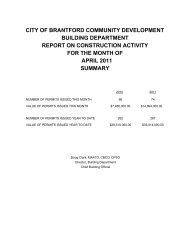Business Retention and Expansion Final Report - City of Brantford
Business Retention and Expansion Final Report - City of Brantford
Business Retention and Expansion Final Report - City of Brantford
You also want an ePaper? Increase the reach of your titles
YUMPU automatically turns print PDFs into web optimized ePapers that Google loves.
29In addition, firms noted that other alternative energy sources (19%) <strong>and</strong> wind energy (17%) would be their preference,however unavailability (48%), cost <strong>of</strong> installation (36%) <strong>and</strong> price (30%) were barriers to such uses in their respectivecommunity.With respect to energy supply, management <strong>and</strong> efficiency, the majority <strong>of</strong> firms (58%) have no concerns. However, thecost <strong>of</strong> energy (78%), inconsistent supply/periodic brownouts (35%) <strong>and</strong> unusually high-energy consumption (17%), are<strong>of</strong> concern to local businesses. In saying this, 61% <strong>of</strong> firms also note that their business would benefit from engineeringor technical support with respect to energy conservation <strong>and</strong> efficiency.The growing dependence <strong>of</strong> information technology (IT) on business operations has steadily increased in recent years.More <strong>and</strong> more, businesses are capitalizing on the various benefits that online applications provide, as the Internetbecomes a mainstay in day-to-day business functions. Marketing (42%), customer service (37%), finance <strong>and</strong> accounting(32%), broadening market potential (25%) <strong>and</strong> E-commerce (online sales transactions) (21%), are the most importantfunctions carried out online by area businesses. In terms <strong>of</strong> online presence, 77% <strong>of</strong> firms have their own website, 65%are on others websites <strong>and</strong> 92% use email.Overall, 85% <strong>of</strong> firms indicate that Internet service in general is somewhat important to their business, with some firmsacknowledging that high-speed satellite <strong>and</strong> high-speed T1 connections are very important.Firms cited that having what was needed (52%), start up costs (22%) <strong>and</strong> the ongoing costs <strong>of</strong> service (20%) are themain barriers to implementing new telecommunication technologies.Looking forward to the next three years, respondents were asked to specify what factors would ensure that their businessremains competitive. Firms indicated that local market development (77%), improved customer service (76%) <strong>and</strong>energy costs (58%) as the most important. The remaining factors <strong>and</strong> their relative importance are outlined in Table 4below.Table 4: Future factors ensuring business competitiveness (next 3 years)Factor Percentage (%)Market development (local) 77Improved customer service 76Energy costs 58Market development (outside local area) 55Strategic marketing 55Availability <strong>of</strong> labour 54<strong>Business</strong> planning 53Workforce health <strong>and</strong> safety 53Workforce skill development 48Availability <strong>of</strong> telecommunications services 45Water/sewer availability 45Water/sewer costs 44Add/change products 43Worker productivity 38Accessing capital 38Strategic alliances 33Exchange rate for Canadian dollar 29Resolution <strong>of</strong> cross border issues 28
















